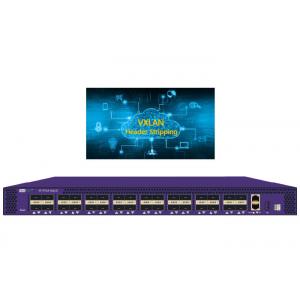
Add to Cart
Network Packet Broker VXLAN Header Stripping VXLAN Forwarding
VXLAN Gateway
There are three main modes of communication between VMS: different VMS under VNI, cross-network access under different VNI, and access between vxlans and non-vxlans.
VXLAN gateway is divided into two layer gateway and three layer gateway.
For end-user communication located in the same network segment, the two-layer gateway receives the user message and forwards it according to BUM(broadcast & unknown - unicast & multicast) or unicast based on the destination MAC type contained in the message.
Three-tier gateways are used for communication between end users not on the same network segment or between VXLAN and non-vxlan users.
Two-layer Gateway
VXLAN layer 2 gateway workflow
The workflow of VXLAN layer gateway is divided into BUM message forwarding workflow and VXLAN unicast forwarding workflow.
Workflow of VXLAN BUM Message Forwarding
When the BUM message enters the VXLAN tunnel, the access VTEP adopts the head-end replication mode to encapsulate the VXLAN message.The BUM message exits the VXLAN tunnel, and the outlet VTEP unseals the message.
1- Switch_1 receives the message from terminal A, obtains the corresponding two-layer broadcast domain according to the port and VLAN information accessed in the message, and determines whether the destination MAC of the message is BUM MAC.
● yes, broadcast in the corresponding two layer broadcast domain, and jump to 2).
● no, through the known single broadcast text forwarding process.
2- VTEP on Switch_1 obtains the header copy tunnel list of the corresponding VNI according to the corresponding two-layer broadcast domain, and then carries out message copy and VXLAN encapsulation according to the obtained tunnel list.VXLAN header and outer IP information are encapsulated and forwarded from the exit port based on each exit port and VXLAN encapsulation information.
3- After VTEP on Switch_2/Switch_3 receives the VXLAN packet, the validity of the VXLAN packet is judged according to the UDP destination port number, source/destination IP address and VNI.According to VNI, the corresponding two-layer broadcast domain is obtained, and then VXLAN is unsealed to obtain the inner two-layer message, so as to determine whether the destination MAC of the message is BUM MAC.
● yes, broadcast processing is carried out on the non-vxlan side of the corresponding two-layer broadcast domain.
● no, then determine if it is a native MAC.
-- yes, send it to the main machine for processing.
-- no, find the interface and encapsulation information in the corresponding layer broadcast domain, and jump to 4).
4- Switch_2/Switch_3 adds a VLAN Tag to the packet according to the outgoing interface and package information found, and forwards it to the corresponding terminal B/C.
Terminal B/C responds to the message of terminal A and forwards it according to the forwarding process of the broadcast document.
The VXLAN Known Unicast Forwarding Workflow
1- Switch_1 receives the message from terminal A, obtains the corresponding two-layer broadcast domain according to the port and VLAN information accessed in the message, and determines whether the destination MAC of the message is known unicast MAC.
● yes, then determine whether it is native MAC.
-- yes, send it to the main machine for processing.
-- no, find the interface and encapsulation information in the corresponding layer broadcast domain, and jump to 2).
● no, broadcast in the corresponding layer 2 broadcast domain and jump to 2).
2- VTEP on witch_1 performs VXLAN encapsulation and message forwarding based on the outgoing interface and encapsulation information found.
3- After receiving the VXLAN packet at VTEP on Switch_2, the validity of the VXLAN packet is judged according to the UDP destination port number, source/destination IP address and VNI.According to VNI, the corresponding two-layer broadcast domain is obtained, and then VXLAN is unsealed to obtain the inner two-layer message, so as to determine whether the destination MAC of the message is known single broadcast MAC.
● yes, find the interface and encapsulation information in the corresponding layer broadcast domain, and jump to 4).
● no, then determine if it is a native MAC.
-- yes, send it to the main machine for processing.
-- no, through the BUM message forwarding process.
4- Switch_2 adds a VLAN Tag to the packet according to the outgoing interface and encapsulation information found and forwards it to the corresponding terminal B.
VLAN Comparing VxLAN

Three Layers Gateway
Communication between vxlans of different network segments, and communication between vxlans and non-vxlans, need to be realized through IP routing.
BD was created on the three-layer gateway, and the VNI was mapped to BD in a 1:1 manner. BDIF interface was created based on BD, and the IP address was configured through the BDIF interface to realize the communication between vxlans of different network segments, as well as between VXLAN and non-vxlan.
The BDIF interface is similar to the VLANIF interface.
Three Layers Gateway Classification
L3 gateway is divided into centralized gateway and distributed gateway.
Centralized Gateway
All network gateways are centrally deployed on a single device, and all cross-network access flows need to go through a centralized gateway.North-south/east-west traffic needs to go through the gateway, and local cross-subnet traffic is forwarded through the centralized gateway, with traffic detour.

Distributed Gateway
Cross-subnet traffic is also the optimal path forwarding, only north-south flow pressure, no east-west flow pressure.In a typical spin-leaf networking deployment, gateways can be distributed across all leaf nodes to solve the problem of centralized gateways.

Recommend Network Packet Broker for VXLAN Header Stripping in Original Packet and Metadata
